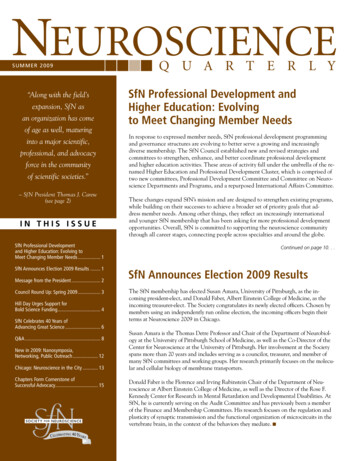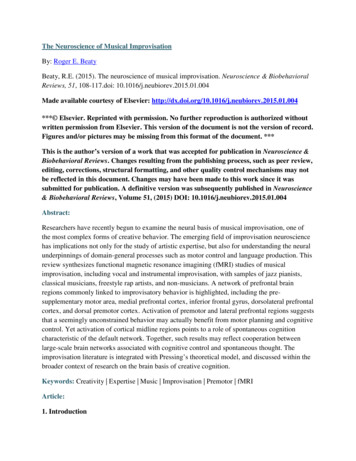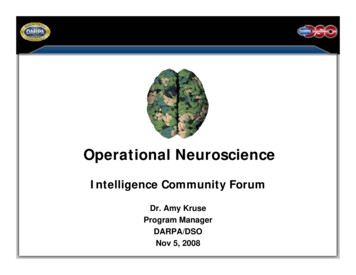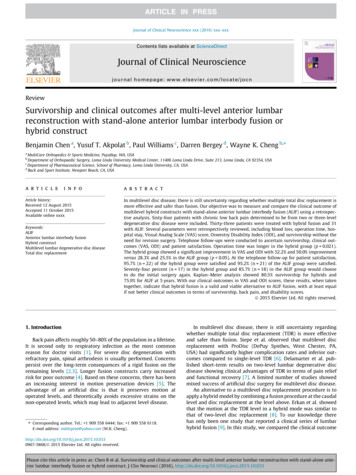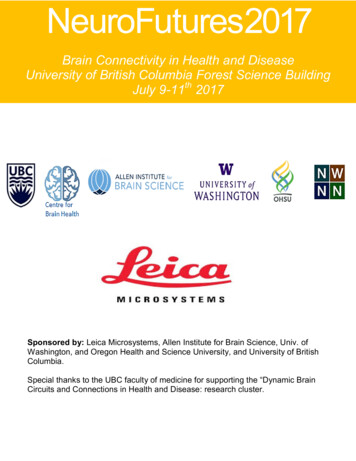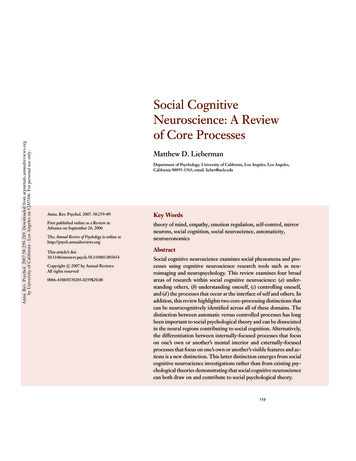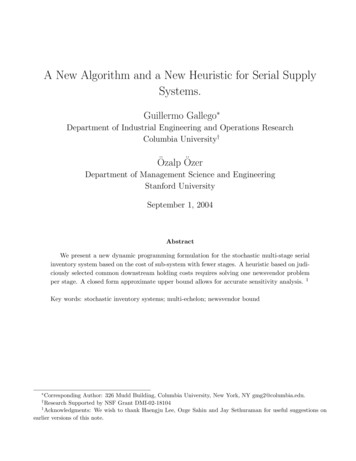
Transcription
The Milton H. Erickson Institute of the California Central CoastTHE NEW NEUROSCIENCE OFPSYCHOTHERAPY, THERAPEUTIC HYPNOSIS& REHABILITATION:A CREATIVE DIALOGUE WITH OUR GENESErnest Lawrence Rossi, Ph.D. & Kathryn Lane Rossi, Ph.D.1
Copyright 2008byErnest Lawrence Rossi, Ph.D. & Kathryn Lane Rossi, Ph.D.All rights reserved. No part of this book may be reproduced in any manner whatever, in wholeor in part (except for brief quotations and critical articles or reviews), without writtenpermission from the authors.Published by:Ernest Lawrence Rossi, Ph.D. and Kathryn Lane Rossi, Ph.D.125 Howard AvenueLos Osos CA 93402USAWWW.ErnestRossi.comEmail: Ernest@ErnestRossi.comEmail: Kathryn@ErnestRossi.comVersion 2.0, September 20082
Table of ContentsCHAPTER 1An Introduction to Milton H. Erickson, M.D. (1901-1980) . . . . . . . . . 5CHAPTER 2Historical Sources of Our New Neuroscience ofPsychotherapy, Therapeutic Hypnosis, and Rehabilitation . . . . . . . . . 8CHAPTER 3A New Neuroscience Model of the Four Stage Creative Processin the Humanities, Science and Psychotherapy . . . . . . . . . . . . . . . . 10CHAPTER 4Gene Expression, Brain Plasticity and Time in Psychotherapy . . . . . 18CHAPTER 5Life Turning Points: An Evolutionary Perspective on Self Creation,Dreaming and the Constructive Mind . . . . . . . . . . . . . . . . . . . . . . . . 24CHAPTER 6Mirror Neurons, Empathy, and ConflictArt, Truth and Beauty via Gene Expression and Brain Plasticity . . . . 28CHAPTER 7A Musical InterludeThe Sonata Form of the Four Stage Creative Process . . . . . . . . . . . . 35CHAPTER 8Four-Stage Creative Psychotherapy: Constructing Future Mind . . . 40CHAPTER 9Therapeutic Process #1The Four Stage Creative Process with Hand Mirroring . . . . . . . . . . . 47CHAPTER 10Therapeutic Process #2The Psychotherapeutic Facilitation of Clarity and Strength . . . . . . . 50CHAPTER 11Therapeutic Process #3Facilitating Consciousness & Creativity Integrating the Opposites. . 523
CHAPTER 12Therapeutic Process #4The Merry Symptom Chase for Mind-Body Healing . . . . . . . . . . . . . 55CHAPTER 13EpigeneticsThe Psychosocial Genomics of Gene Expression and Brain Plasticity. 58CHAPTER 14Workshop Evaluation & Research Form . . . . . . . . . . . . . . . . . . . . . . . 62References . . . . . . . . . . . . . . . . . . . . . . . . . . . . . . . . . . . . . . . . . . . . . . . . . . . . 63Table of Figures & TablesFigure 1: Cartoon of the Classic 4-Stage Creative Process . . . . . . . . . . . . . .10Figure 2: A Profile of the Human Brain during “Offline” Periods of Sleep. .12Figure 3: The Mind-Body Human Sensory-Motor Homunculus . . . . . . . . . .13Figure 4: Four Levels of the Psychobiological Domain of Psychotherapy . .14Figure 5: Neuron Illustration of Time Parameters of the Ultradian BRAC. .16Figure 6: Time Parameters of the Division of the Cells. . . . . . . . . . . . . . . . .19Figure 7: A Profile (90-120 minutes) of the 4-Stage Creative Process . . . . .20Table 1: Comparison of Ultradian Healing and Stress Responses . . . . . . . .21Figure 8: Domain of Hypnotherapeutic Work: High and Low Phases. . . . . .22Figure 9: Adaptive Dynamics during Life Transitions. . . . . . . . . . . . . . . . . . .24Figure 10: Mirror Neurons in Adaptive Dynamics . . . . . . . . . . . . . . . . . . . . .31Figure 11: The 4-Stage Outline of the Sonata Musical Form. . . . . . . . . . . . .35Figure 12: Therapeutic Process #1: Hand Mirroring. . . . . . . . . . . . . . . . . . . .48Figure 13: Therapeutic Process #2: Buddha Beneficence – Fear Not . . . . . .50Figure 14: Therapeutic Process #3: Integrating the Opposites . . . . . . . . . . .53Figure 15: Therapeutic Process #4: Transforming Symptoms into Signals. .55Figure 16: Social Group Influence of Gene Expression/Brain Plasticity. . . .58Table 2: Mind Modulation of Gene Expression in Human Leukocytes. . . . 604
CHAPTER 1An Introduction toMilton H. Erickson, M.D. (1901-1980)Milton H. Erickson, was described as “one of the most influential psychotherapists of all time” ina recent survey by The Psychotherapy Networker (March 2006). In psychotherapy Milton H.Erickson is ranked among the Top Ten along with Sigmund Freud, Carl Jung and others. Here istheir brief portrait of Erickson written about him a generation after his passing.“Despite everything that's been written about Milton Erickson and the diligent effortsof so many to understand just what he did in therapy and why it worked so remarkablywell, an air of mystery surrounds his work even now. Shortly after Erickson's death, his20-year student Jay Haley said, “Not a day passes that I don't use something that Ilearned from Erickson in my work. Yet his basic ideas I only partially grasp.” The imageof Erickson that's emerged in the field is that of a therapeutic wizard possessed of anoverwhelming personal power.“He wasn't the kind of person you'd just sit down and chat with,” recalls Jeffrey Zeig.“He was consistently working, consistently being Milton Erickson, which entailedhaving the most profound experience he could with whomever he was sitting with. Inthat sense, he was constantly hypnotic, constantly therapeutic, constantly teaching.”Perhaps this was because Erickson’s physical state necessitated the complete focus ofall his faculties. Dyslexic, tone deaf, color blind, prone to vertigo and disorientation,stricken with polio at 17 and again at 51, he spent the last 13 years of his life (theperiod in which many of his well-known students first met him) painfully confined to awheelchair. As he tried to model the flexibility and subtle verbal methods he'd spent alifetime developing, he did so with partially paralyzed lips and a dislocated tongue.Yet, as Haley said, “the man worked 10 hours a day, six or seven days a week doingtherapy. . . . Every weekend, he was either seeing patients or on the road teaching.”Zeig adds: “The thing that was so impressive about Erickson was the time and energyhe was willing to put out. Once he took somebody as a patient, he'd, literally, doanything he possibly could to help that person. When you were a client of Erickson, youjust felt he was totally focused on you.”Erickson spent a half-century developing an enormously subtle therapy of multileveledpattern recognition that was almost totally at odds with the mainstream therapies ofhis day. “Maladies,” Erickson said, “whether psychogenic or organic, follow definite5
patterns of some sort, particularly in the field of psychogenic disorders. A disruption ofthis pattern can be a most therapeutic measure, and it often matters little how smallthe disruption is, if introduced early enough.”He discovered that most of the “rules” of life prescribing human limitations werearbitrary beliefs, not facts. His study and mastery of hypnosis taught him that alteredmental states and trance were very much a part of everyday functioning. “Thisunderstanding,” wrote Ernest Rossi, “formed the underlying principles of his laterstudies of psychopathology as well as his development of the naturalistic andutilization approaches to therapeutic hypnosis.”Such insights were fundamental to Erickson's approach, but he sought no definitetheory to pass on as a legacy. “Erickson has no set method,” Haley noted. “If oneprocedure doesn't work, he tries others until one does. That's what he emphasized tohis students, advising a stance of heightened receptivity uncontaminated by formulaicpreconceptions.” Erickson put it this way: “I don't attempt to structure mypsychotherapy except in a vague, general way. And in that vague general way, thepatient structures it in accordance with his own needs The first consideration indealing with patients is to realize that each of them is an individual So in dealing withpeople, you try not to fit them into your concept of what they should be You shouldtry to discover what their concept of themselves happens to be It isn't the amount oftime. It isn't the theory of therapy. It's how you reach the personality by saying theright thing at the right time.”Further words of wisdom from Erickson: “Trust your unconscious. It's a very delightfulway of living, a very delightful way of accomplishing things.” And: “Don't try to usesomebody else's technique Just discover your own.”We believe these words, “Don't try to use somebody else's technique Just discover your own”are very important for therapists who wish to learn about themselves as well as Erickson.Therapists usually learn through trial and error the ways in which their unique personality canbe most effective in helping others. This requires courage, persistence, and honesty by eachpsychotherapist. It can be a lonely task learning how to do this.Who can possibly know better that you, yourself, when you are at your best and most effectivein facilitating others? It requires careful and continuous self reflection about what one is doing.No two people are exactly alike. No two therapeutic sessions can be exactly the same. Eachtherapeutic session is a unique creation, a unique piece of self development in the genesis ofnew consciousness and self identity in the patient and therapist. We expect that our empathy,understanding, and therapeutic efficacy will grow with each human encounter day by day.This essay for licensed professionals presents a new neuroscience perspective onpsychotherapy, therapeutic hypnosis, and rehabilitation as highly personal and creative6
dialogues with our genes. While this presentation is implied by much of the research we willquote, a great deal of further research will be needed to establish its scientific validity andtherapeutic efficacy. We outline a number of “experiential processes” as guiding heuristics fortherapeutic work. They are not, however, validated methods behavior change at this time.Rather, our approaches should be regarded as personal forms of self development in thehumanistic arts, autobiography, and meditation. They may be useful in the creation of newconsciousness, self knowledge, and self care that are of value to individuals who practice them,but they are not medical or psychological prescriptions for everyone. We begin with a briefoverview of some of our creative approaches in the history of the arts, medicine, andpsychotherapy as well as evolving neuroscience.Creative Implications Learning from others is only a beginning.Each therapist must develop their own special talents.Daily creative effort is required to optimize therapeutic skills.Each therapeutic session is a unique creation.7
CHAPTER 2Historical Sources of the NewNeuroscience of Psychotherapy,Therapeutic Hypnosis, andRehabilitationThe earliest sources of psychotherapy and therapeutic hypnosis began almost 300 years agowith Anton Mesmer’s defense of his medical thesis Dissertatio Physico-Medica de PlanetarumInfluxu on May 27, 1766. This was the time of the Swiss philosopher, Jean-Jacques Rousseau(1712-1778), when there were philosophical clashes between the mechanistic and naturalisticviews of human nature. Rousseau believed humans experienced developmental stages and thatthe “exercise” of mental abilities facilitated the growth of the brain. Charles Bonnet (17201793), an experimental naturalist familiar with Rousseau’s views, proposed to the Italianscientist Michele Vincenzo Malacarne (1744-1816) that neurons could respond to exercise justas muscles do. Malacarne (1793, 1819) then carried out experiments with littermates of birdsand dogs. He observed that those exposed to enriched environments and intensive training hadlarger brains! This was the forerunner of modern neuroscience research documenting hownovelty, exercise, training, and the voluntary focusing of attention can facilitate the growth andre-organization of neural networks of the brain. This is the foundation of our currentconceptions of how gene expression and brain plasticity in psychotherapy, therapeutic hypnosis,and rehabilitation can facilitate human development and healing (Rosenzweig, 1996,Rosenszweig, et al., 1962, Renner & Rosenzweig, 1987).The Physiology of Fascination in Therapeutic Hypnosis,Psychotherapy, and Modern NeuroscienceMedical pioneers such as Anton Mesmer (1734-1815) and James Braid, M.D. (1795-1860), whooriginally explored therapeutic hypnosis as a method of healing, had little understanding of howit actually worked. For example, James Braid’s defines hypnotism in his 1855 book, ThePhysiology of Fascination as follows:With the view of simplifying the study of reciprocal actions and reactions of mind andmatter upon each other. the (hypnotic) condition arose from influences existing withinthe patient's own body, viz., the influence of concentrated attention, or dominantideas, in modifying physical action, and these dynamic changes re-acting on the mindof the subject. I adopted the term “hypnotism" or nervous sleep for this process And8
finally as a generic term, comprising the whole of these phenomena which result fromthe reciprocal actions of mind and matter upon each other, I think no term moreappropriate than ‘psychophysiology’ (Braid, 1855).It is now believed that Braid actually invented the term “psychophysiology” to describe howmind and matter interact with each other to facilitate mind-body healing via therapeutichypnosis (Tinterow, 1972). Even today, 150 years later, exactly how psychophysiology operatesin mind-body therapy is not well understood. There are no generally recognized departments oftherapeutic hypnosis or mind-body therapy in our universities and medical schools that conductsystematic research on these therapies. Within the past generation, however, the newdiscipline of neuroscience has emerged with the advent of new technologies for the scientificinvestigation of the natural relationships between mind and body that Erickson (1958/2008,1959/2008) called his “naturalistic” and “utilization” techniques of hypnosis. Functionalmagnetic resonance imaging (fMRI), DNA microarrays, and bioinformatic DNA databases, forexample, have made
originally explored therapeutic hypnosis as a method of healing, had little understanding of how it actually worked. For example, James Braid’s defines hypnotism in his 1855 book, The Physiology of Fascination as follows: With the view of simplifying the study of reciprocal actions and reactions of mind and matter upon each other. the (hypnotic) condition arose from influences existing .
